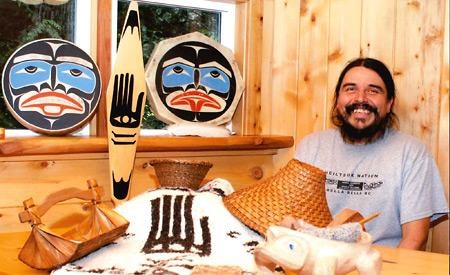A carved Coast Salish totem stands as a sentinel over the Vancouver Island University Powell River Campus.
Despite being a modern work of art, the totem carries with it the same stoic presence, an inherent wisdom, or an ancient silence one would expect to see in a totem pole standing on a lonely shore on Haida Gwaii, or up one of the desolate inlets of the BC coastline. Its aspect is testament to Ivan Rosypskye’s dedication to his art.
Rosypskye is a master carver and basket weaver.
“The totem is called Cheh Cheh Hum,” he said. “It means to be welcome in the Tla’amin language.”
The arms are open as if to embrace whoever would stop to look at it. It’s an historical gesture typically used by an Elder or some respected person within the Coast Salish First Nations community.
Though formally trained in the Coast Salish carving tradition, Rosypskye is a Heiltsuk First Nation (Bella Bella) carver who apprenticed under the late Tsimshian master carver and storyteller Victor Reece. Historically, the Heiltsuk were masterful at carving canoes and noted for their artistic skill. With the development of the fur trade, Heiltsuk canoe carvers became adept at building European ships.
Rosypskye’s art and traditional carvings have garnered him attention around the globe. “I’m getting orders from all over the place,” he explained. “Slowly my work is being recognized. But it takes time and should be done properly and according to tradition. There is no hurrying.” His portfolio includes cover art designed for the Tla’amin (Sliammon) First Nation Agreement in Principle government document; a ceremonial paddle that was given to a neighbouring first nation chief at the Tla’amin treaty signing ceremony in March of this year; and a carved Coast Salish spindle whorl that was used in the DIGS (discover imagine grow schoolyard) mural project and artists in residence program at James Thompson Elementary School.
Rosypskye’s exemplary work and dedication to his craft recently attracted Bert Finnamore, heritage director at Powell River Historical Museum and Archives. Finnamore explained, during a City of Powell River budget committee presentation, that the museum was considering the possibility of taking Rosypskye on as artist in residence as they develop their plans to expand museum operations.
Rosypskye’s baskets, masks, carved panels, drawings, rattles, intricate woven baskets and ceremonial paddles all radiate an almost indecipherable quality that somehow conjures a subtle reverence. It is an ephemeral quality—more a feeling than an idea. It is true in its form, and easily reminiscent of Bill Holm’s study Northwest Coast Indian Art: An Analysis of Form.
Rosypskye’s work emulates fluidity, true lines and aesthetic presentation that in some measure captures the essence of history it upholds.



